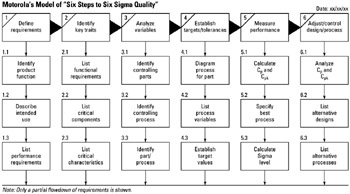Tool 203: Top-Down Flow Chart
| AKA | N/A |
| Classification | Planning/Presenting (PP) |
Tool description
A top-down flow chart illustrates the major steps in an organizational work process or project. It shows the essential requirements, sequenced from left to right, with a number of substeps listed below each step. This flow chart has an advantage of showing the complete process without too much detail, therefore allowing a team to quickly understand the problem solving or process-improvement opportunities of the process.
Typical application
-
To display all necessary steps in a work process or project.
-
To provide an overall picture of a top-level process.
Problem-solving phase
| Select and define problem or opportunity | |
| → | Identify and analyze causes or potential change |
| → | Develop and plan possible solutions or change |
| Implement and evaluate solution or change | |
| Measure and report solution or change results | |
| Recognize and reward team efforts |
Typically used by
| Research/statistics | |
| Creativity/innovation | |
| 1 | Engineering |
| 2 | Project management |
| 4 | Manufacturing |
| Marketing/sales | |
| Administration/documentation | |
| Servicing/support | |
| Customer/quality metrics | |
| 3 | Change management |
before
-
Storyboarding
-
Systems Analysis Diagram
-
House of Quality
-
Process Selection Matrix
-
Information Needs Analysis
after
-
Basili Data Collection Method
-
Process Analysis
-
Action Plan
-
Resource Requirements Matrix
-
Gantt Chart
Notes and key points
-
Designations of Top-Down Flow Chart elements:

Step-by-step procedure
-
STEP 1 A facilitator explains the purpose of a top-down flow chart to the team participants. The team identifies the process.
-
STEP 2 The participants identify essential, major process steps.
-
STEP 3 Team consensus is reached to select a final 5–7 process steps to be drawn on a whiteboard or flip chart. See example Motorola's Model of "Six Steps to Six Sigma Quality".
-
STEP 4 The facilitator draws the top-down flow chart and asks participants to provide 4–5 sub-steps for each process step drawn.
-
STEP 5 Identified substeps are discussed, changed, and finally listed under each major step.
-
STEP 6 Finally, the facilitator provides numerical identification numbers and substep level numbers and dates the flow chart, as shown in the example.
Example of tool application

EAN: 2147483647
Pages: 326